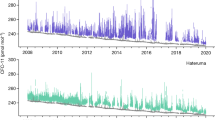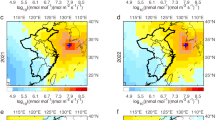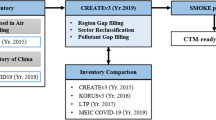Abstract
1-Chloro-1,1-difluoroethane (HCFC-142b) was both ozone depleting substance under restriction of the Montreal Protocol on Substances that Deplete the Ozone Layer (Montreal Protocol) and potent greenhouse gas with high GWP. Controlling its emissions in China will contribute to both mitigating climate change and protecting ozone. A national emission inventory of HCFC-142b for China during 2000–2012 was established and projected to 2050 based on the 2006 IPCC Guidelines for National Greenhouse Gas Inventories and the Montreal Protocol, showing that (i) in contrast to the downward trend revealed by existing researches, HCFC-142b emissions kept increasing from 0.1 kt/y in 2000 to the peak of 14.4 kt/y in 2012, making China a crucial contributor to global HCFC-142b emissions and (ii) for future emission projections, a continuous increase from 14.9 kt/y in 2013 to 97.2 kt/y in 2050 was anticipated under the business-as-usual (BAU) scenarios, while a reduction of about 90% of the projected BAU emissions would be obtained by fulfilling the Montreal Protocol, namely an accumulative mitigation of 1578 kt HCFC-142b from 2013 to 2050, equal to 103 kt ODP and 3504 Tg CO2 emissions. Emissions from each province in 2012 were also estimated to identify key emission areas. Among the 31 mainland provinces in China (Hong Kong, Macao, and Taiwan were not included), Jiangsu, Zhejiang, Shandong, and Guangdong had the highest emission rates in 2012 (2.06, 1.85, 1.52, and 1.04 kt/y, respectively); Zhejiang, Jiangsu, and Shanghai exhibit the strongest emission strength (0.83, 0.59, and 0.54 t/km2, respectively), much higher than the average national level of 0.33 t/km2.




Similar content being viewed by others
References
Metz B, Kuijpers L, Solomon S et al (2005) Safeguarding the ozone layer and the global climate system: issues related to hydrofluorocarbons and perfluorocarbons. Cambridge University Press, Cambridge, p 5
Wingenter OW, Kubo MK, Blake NJ et al (1996) Hydrocarbon and halocarbon measurements as photochemical and dynamical indicators of atmospheric hydroxyl, atomic chlorine, and vertical mixing obtained during Lagrangian flights. J Geophys Res 101:4331–4340
Prinn RG, Weiss RF, Miller BR et al (1995) Atmospheric trends and lifetime of CH3CCl3 and global OH concentration. Science 269:187–192
Pinnock S, Hurley MD, Shine KP et al (1999) Radiative forcing of climate by hydrochlorofluorocarbons and hydrofluorocarbons. J Geophys Res 100:23227–23238
Bonasoni P, Laj P, Angelini F et al (2008) The ABC-Pyramid Atmospheric Research Observatory in Himalaya for aerosol, ozone and halocarbon measurements. Sci Total Environ 391:252–261
UNEP Ozone Secretariat (2009) Handbook for the Montreal protocol on substances that deplete the ozone layer. UNEP/Earthprint, Kenya
Forster PM, Ramaswamy V, Artaxo P et al (2007) Changes in atmospheric constituents and in radiative forcing. Climate change 2007: the physical science basis. Contribution of Working Group I to the Fourth Assessment Report of the Intergovernmental Panel on Climate Change. Cambridge University Press, Cambridge, pp 129–234
Clerbaux C, Cunnold DM, Anderson J et al (2007) Long-lived compounds chapter 1 in scientific assessment of ozone depletion: 2006, Global Ozone Research and Monitoring Project—Report No. 50, 527 pp, World Meteorological Organization, Geneva p 12
Montzka SA, Reimann S, Eagle A et al (2011) Ozone-depleting substances (ODSs) and related chemicals chapter 1 in scientific assessment of ozone depletion: 2010, Global Ozone Research and Monitoring Project—Report No. 52, 516 pp, World Meteorological Organization, Geneva p 21
Montzka SA, Hall BD, Elkins JW (2009) Accelerated increases observed for hydrochlorofluorocarbons since 2004 in the global atmosphere. Geophys Res Lett 36:L03804
UNEP Ozone Secretariat (2007) Report of the nineteenth meeting of theoarties to the Montreal Protocol on substances that deplete the ozone layer. Decision XIX/6: Adjustments to the Montreal Protocol with regard to Annex C, Group I, substances (hydrochlorofluorocarbons), http://ozone.unep.org/new_site/en/Treaties/treaties_decisions-hb.php?meet_id=203&show_all
Vollmer MK, Zhou LX, Greally BR et al (2009) Emissions of ozone-depleting halocarbons from China. Geophys Res Lett 36:L15823
Li S, Kim J, Kim KR et al (2011) Emissions of halogenated compounds in east Asia determined from measurements at Jeju island, Korea. Environ Sci Technol 45:5668–5675
Kim J, Li S, Kim KR et al (2010) Regional atmospheric emissions determined from measurements at Jeju island, Korea: halogenated compounds from China. Geophys Res Lett 37:L12801
Fang X, Wu J, Su S et al (2012) Estimates of major anthropogenic halocarbon emissions from China based on interspecies correlations. Atmos Environ 62:26–33
Shao M, Huang D, Gu D et al (2011) Estimate of anthropogenic halocarbon emission based on measured ratio relative to CO in the Pearl River delta region, China. Atoms Chem Phys 11:5011–5025
Fang X, Wu J, Xu J et al (2012) Ambient mixing ratios of chlorofluorocarbons, hydrochlorofluorocarbons and hydrofluorocarbons in 46 Chinese cities. Atmos Environ 54:387–392
Yao B, Vollmer Martin K, Xia LZ et al (2012) A study of four-year HCFC-22 and HCFC-142b in-situ measurements at the Shangdianzi regional background station in China. Atmos Environ 63:43–49
Stohl A, Kim J, Li S et al (2010) Hydrochlorofluorocarbon and hydrofluorocarbon emissions in East Asia determined by inverse modeling. Atoms Chem Phys 10:3545–3560
College of Environmental Sciences, Peking University (2012) HCFCs phasing-out management plan for China. Peking University, Beijing
Eggleston S, Buendia L, Miwa K, et al (2006) Volume 3: industrial process and product use in 2006 IPCC Guidelines for National Greenhouse Gas Inventories. Hayama, Kanagawa, Japan
Yan H, Zhang J (2010) Emission inventory prediction of HCFC-141b in China. Acta Sci Nat Univ Pekin 47:875–881
Wan D, Xu J, Zhang J et al (2009) Historical and projected emissions of major halocarbons in China. Atmos Environ 43:5822–5829
Harvey LDD (2007) Net climatic impact of solid foam insulation produced with halocarbon and non-halocarbon blowing agents. Build Environ 42:2860–2879
Harnisch J, Hohne N, Koch M et al (2003) Risks and benefits of fluorinated greenhouse gases in processes and products under special consideration of the properties intrinsic to the substance. German Federal Environmental Agency (UBA), Berlin
Paquet AN, Mutton J, Lee SP (2009) Global atmospheric emissions model of HCFC142b with respect to extruded polystyrene foam applications. J Cell Plast 45:243–278
Vo CV, Paquet AN (2004) An evaluation of the thermal conductivity of extruded polystyrene foam blown with HFC-134a or HCFC-142b. J Cell Plast 40:205–228
Li YF, Scholtz MT, Van Heyst BJ (2003) Global gridded emission inventories of β-hexachlorocyclohexane. Environ Sci Technol 37:3493–3498
NBS (National Bureau of Statistics) (2012) China statistical yearbook 2012. China Statistical Publishing House, Beijing
Yang H (2009) Emission allocation and concentration calculation of HCFC-22 in China. Dissertation. Peking University
College of Environmental Sciences, Peking University (2007) Study on the strategy for the long term management of HCFCs in China. Submitted to the 51st Meeting of the Executive Committee of the Multilateral Fund of the Montreal Protocol. Peking University, Beijing
Acknowledgments
This work was supported by the State Key Laboratory Program of China (09Z02ESPCP).
Author information
Authors and Affiliations
Corresponding author
About this article
Cite this article
Han, J., Li, L., Su, S. et al. Estimated HCFC-142b emissions in China: 2000–2050. Chin. Sci. Bull. 59, 3046–3053 (2014). https://doi.org/10.1007/s11434-014-0337-z
Received:
Accepted:
Published:
Issue Date:
DOI: https://doi.org/10.1007/s11434-014-0337-z




